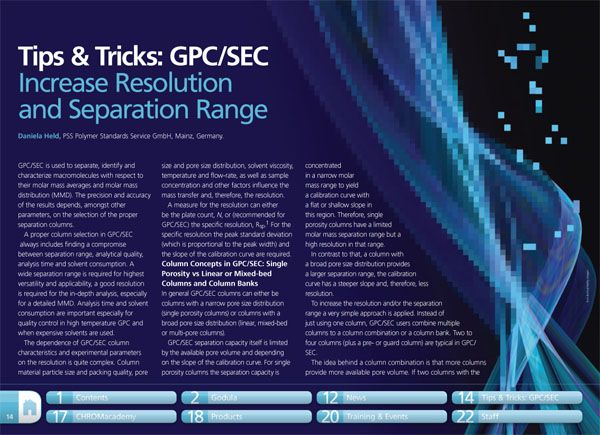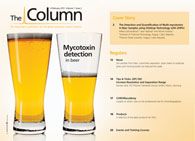Tips & Tricks: GPC/SEC Increase Resolution and Separation Range
The precision and accuracy of the results depends, amongst other parameters, on the selection of the proper separation columns.
GPC/SEC is used to separate, identify and characterize macromolecules with respect to their molar mass averages and molar mass distribution (MMD). The precision and accuracy of the results depends, amongst other parameters, on the selection of the proper separation columns.
A proper column selection in GPC/SEC always includes finding a compromise between separation range, analytical quality, analysis time and solvent consumption. A wide separation range is required for highest versatility and applicability, a good resolution is required for the in-depth analysis, especially for a detailed MMD. Analysis time and solvent consumption are important especially for quality control in high temperature GPC and when expensive solvents are used.
The dependence of GPC/SEC column characteristics and experimental parameters on the resolution is quite complex. Column material particle size and packing quality, pore size and pore size distribution, solvent viscosity, temperature and flow-rate, as well as sample concentration and other factors influence the mass transfer and, therefore, the resolution.
A measure for the resolution can either be the plate count, N, or (recommended for GPC/SEC) the specific resolution, Rsp. For the specific resolution the peak standard deviation (which is proportional to the peak width) and the slope of the calibration curve are required.
Accelerating Monoclonal Antibody Quality Control: The Role of LC–MS in Upstream Bioprocessing
This study highlights the promising potential of LC–MS as a powerful tool for mAb quality control within the context of upstream processing.
Using GC-MS to Measure Improvement Efforts to TNT-Contaminated Soil
April 29th 2025Researchers developing a plant microbial consortium that can repair in-situ high concentration TNT (1434 mg/kg) contaminated soil, as well as overcome the limitations of previous studies that only focused on simulated pollution, used untargeted metabolone gas chromatography-mass spectrometry (GC-MS) to measure their success.
Prioritizing Non-Target Screening in LC–HRMS Environmental Sample Analysis
April 28th 2025When analyzing samples using liquid chromatography–high-resolution mass spectrometry, there are various ways the processes can be improved. Researchers created new methods for prioritizing these strategies.
Potential Obstacles in Chromatographic Analyses Distinguishing Marijuana from Hemp
April 28th 2025LCGC International's April series for National Cannabis Awareness Month concludes with a discussion with Walter B. Wilson from the National Institute of Standard and Technology’s (NIST’s) Chemical Sciences Division regarding recent research his team conducted investigating chromatographic interferences that can potentially inflate the levels of Δ9-THC in Cannabis sativa plant samples, and possible solutions to avoid this problem.

.png&w=3840&q=75)

.png&w=3840&q=75)



.png&w=3840&q=75)



.png&w=3840&q=75)












